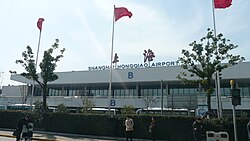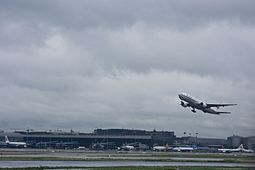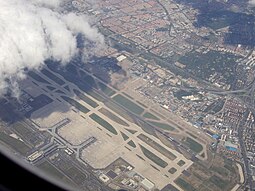Shanghai Hongqiao Airport
| Shanghai Hongqiao Airport 上海 虹桥 机场 |
|
|---|---|

|
|
| Characteristics | |
| ICAO code | ZSSS |
| IATA code | SHA |
| Coordinates | |
| Height above MSL | 3 m (10 ft ) |
| Transport links | |
| Distance from the city center | 13 km southwest of Shanghai |
| Basic data | |
| operator | Shanghai Airport Authority |
| Passengers | 37.960.200
(2014) |
| Air freight | 432,000 t (2014) (2014) |
| Flight movements |
253,325 (2014) |
| Capacity ( PAX per year) |
40 million |
| Runways | |
| 18L / 36R | 3400 m × 45 m asphalt |
| 18R / 36L | 3300 m × 60 m concrete |
The Shanghai Hongqiao Airport ( Chinese 上海虹桥机场 , Pinyin Shànghǎi Hongqiao Jīchǎng ) is an international airport in the districts of Changning and Minhang the government immediate city Shanghai and the oldest airport in the People's Republic of China . It is the fourth largest in terms of passenger numbers and the seventh largest in terms of flight movements in China and is located in two western districts of Shanghai, about thirteen kilometers from the city center.
history
Shanghai Hongqiao Airport was built as a military airfield in 1907 and has also been used for civilian purposes since 1923. After the opening of Shanghai-Pudong Airport in 1999, mostly domestic flights were only operated.
In 2009, 25 million passengers were carried. The airport was already overloaded with domestic flights alone, so that there were delays every day. This was due to the fact that the demand for domestic flights in China is steadily increasing and the airport, which previously had only one runway, was not designed for such a volume. In the meantime, an expansion has eliminated the bottlenecks. Hongqiao Airport now has two runways (3400 by 58 m each), allowing over 33 million passengers in 2011 and 37 million in 2014.
Extension buildings
On March 16, 2010, just in time for Expo 2010, Terminal 2 and a new runway went into operation after a three-year construction period. The terminal built opposite to the west is almost a thousand meters long, the new parking spaces are also designed for the use of the Airbus A380 wide-body aircraft. The airport's capacity increased to 40 million passengers by 2015. Of this, 30 million will go to the new terminal and 10 million to the old terminal. 33 take-offs and landings are possible per hour. The two Shanghai international airports together currently offer a passenger capacity of 120 million passengers a year.
Airlines and Destinations
The airport is a hub for the domestic flights of the following four Chinese airlines (as of February 2016):
Transport links
Several bus lines offer an inexpensive option for onward travel: The “Airport Line No.1” connects Shanghai-Hongqiao Airport with Shanghai-Pudong Airport, approx. 50 kilometers away . Buses run every 20 to 30 minutes, the one-way trip takes about an hour and costs 30 RMB . The Pudong District can be reached by taking the Route No. 938 "for 7 RMB every 5-15 minutes. "Route No. 941" runs to Shanghai Central Station for 4 RMB every 10-12 minutes.
Taxis also leave from right outside the terminal. The prices start with 14 to 18 RMB for the first three kilometers and then cost between 2.50 RMB and 4.60 RMB for each additional kilometer, depending on the time and number of kilometers.
With the opening of the new terminal, the western extension of Metro Line 2, which leads to the new terminal, went into operation at the same time. It has since connected the two airports in Shanghai with each other. Line 10 was also connected to the terminal in 2010.
On July 1, 2010, the Shanghai-Hongqiao railway station was opened west of the new Terminal 2 . It is an important node in Chinese high-speed traffic. The Beijing – Shanghai high-speed line opened in 2011 , as well as the high-speed lines to Hangzhou and Nanjing, serve the station.
Incidents
- On September 17, 1982, the Douglas DC-8-61 JA8048 of Japan Airlines failed essential hydraulic systems after take-off. The pilots returned to Shanghai and made an emergency landing that destroyed the plane but did not kill any of the 124 occupants.
- On April 15, 1999, a cargo plane crashed type MD-11 McDonnell Douglas of Korean Air ( HL7373 ) shortly after taking off from. Due to misunderstandings between the pilots and ignorance, a dive into the terrain was initiated. The three crew members of the cargo plane were killed, as were five bystanders on the ground ( see Korean Air Cargo Flight 6316 ).
See also
Web links
- Airport data on World Aero Data ( 2006 )
- Airport data in the Aviation Safety Network (English)
- Shanghai Airport Authority (English)
Individual evidence
- ↑ 上海 机场 2014 年 完成 旅客 吞吐量 近 9000 万 人次. In: Carnoc News. January 1, 2015, archived from the original on March 4, 2016 ; Retrieved December 17, 2018 (Chinese).
- ↑ a b c Shanghai Daily March 12, 2010, p. 2
- ↑ Hongqiao Airport Terminal 2 , exploreshanghai.com, accessed September 14, 2011
- ^ Accident report JA8048, Aviation Safety Network (English) , accessed on January 16, 2016.
- ↑ http://www.airsafe.com/events/models/md11.htm
- ↑ Aviation Safety Network, accident report HL7373 (English) , accessed on 16 January 2016th



